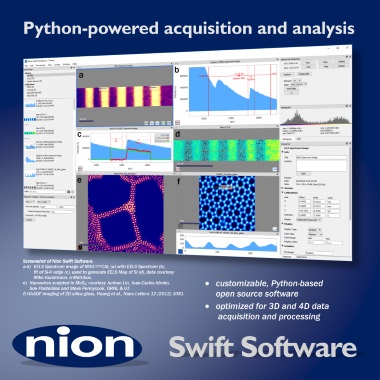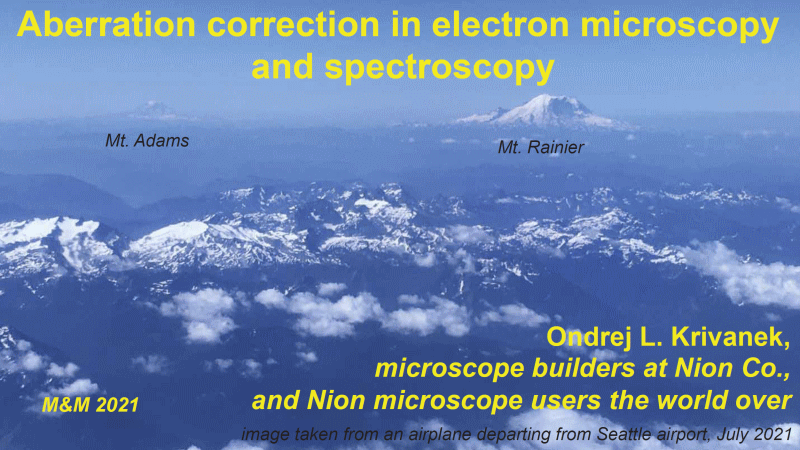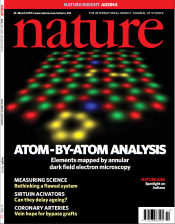
Recorded Nion presentations from the virtual M&M 2021 conference:

Recorded Nion presentations from the virtual M&M 2020 conference:
Key publications on Nion microscopes and the work done with them:
C.A. Gadre, X. Yan, Q. Song, J. Li, L. Gu, H. Huyan, T. Aoki, S.-W. Lee, G. Chen, R. Wu, and X. Pan (2022) "Nanoscale imaging of phonon dynamics by electron microscopy" Nature 606, 292-297
X. Yan, C. Liu, C.A. Gadre, L. Gu, T. Aoki, T.C. Lovejoy, N. Dellby, O.L. Krivanek, D.G. Schlom, R. Wu, and X. Pan (2021) "Single-defect phonons imaged by electron microscopy" Nature 589, 65-69
B. Plotkin-Swing, G.J. Corbin, S. De Carlo, N. Dellby, C. Hoermann, M.V. Hoffman, T.C. Lovejoy, C.E. Meyer, A. Mittelberger, R. Pantelic, L. Piazza, and O.L. Krivanek (2020) "Hybrid pixel direct detector for electron energy loss spectroscopy" Ultramicroscopy 217, 113067
F.S. Hage, G. Radtke, D.M. Kepaptsoglou, M. Lazzeri, and Q.M. Ramasse (2020) "Single-atom vibrational spectroscopy in the scanning transmission electron microscope" Science 367, 1124-1127
J.A. Hachtel, J. Huang, I. Popovs, S. Jansone-Popova, J.K. Keum, J. Jakowski, T.C. Lovejoy, N. Dellby, O.L. Krivanek, and J.-C. Idrobo (2019) "Identification of site-specific isotopic labels by vibrational spectroscopy in the electron microscope" Science 363, 525-528
T.C. Lovejoy, G.C. Corbin, N. Dellby, M.V. Hoffman, and O.L. Krivanek (2018) "Advances in Ultra-High Energy Resolution STEM-EELS" Microscopy and Microanalysis 24, 446-447
M.T. Hotz, G. Corbin, N. Dellby, and T.C. Lovejoy (2018) "Optimizing the Nion STEM for In-Situ Experiments" Microscopy and Microanalysis 24, 1132-1133
F.S. Hage, R.J. Nicholls, J.R. Yates, D.G. McCulloch, T.C. Lovejoy, N. Dellby, O.L. Krivanek, K. Refson, and Q.M. Ramasse (2018) "Nanoscale momentum-resolved vibrational spectroscopy" Science Advances 4, eaar7495
M.J. Lagos, A. Trügler, U. Hohenester, and P.E. Batson (2017) "Mapping vibrational surface and bulk modes in a single nanocube" Nature 543, 529-532
O.L. Krivanek, T.C. Lovejoy, and N. Dellby (2015) "Aberration‐corrected STEM for atomic‐resolution imaging and analysis" Journal of Microscopy 259, 165-172
C.E. Meyer, N. Dellby, Z. Dellby, T.C. Lovejoy, M.C. Sarahan, G.S. Skone, and O.L. Krivanek (2014) "Using Nion Swift for Data Collection, Analysis and Display" Microscopy and Microanalysis 20, 1108-1109
O.L. Krivanek, T.C. Lovejoy, N. Dellby, T. Aoki, R.W. Carpenter, P. Rez, E. Soignard, J. Zhu, P.E. Batson, M.J. Lagos, R.F. Egerton, and P.A. Crozier (2014) "Vibrational spectroscopy in the electron microscope" Nature 514, 209-212
O.L. Krivanek, T.C. Lovejoy, M.F. Murfitt, G.S. Skone, P.E. Batson, N. Dellby (2014) "Towards sub-10 meV energy resolution STEM-EELS" J. Phys. Conf. Series 522, 012023
T.C. Lovejoy, Q.M. Ramasse, M. Falke, A. Kaeppel, R. Terborg, R. Zan, N. Dellby, and O.L. Krivanek (2012) "Single atom identification by energy dispersive x-ray spectroscopy" 100, 154101
N. Dellby, N.J. Bacon, P. Hrncirik, M.F. Murfitt, G.S. Skone, Z.S. Szilagyi and O.L. Krivanek (2011) "Dedicated STEM for 200 to 40 keV operation" The European Physical Journal Applied Physics 54, 33505 (11 pages).
 First atom-by-atom identification of every atom present in a significant part of a non-periodic sample (performed using a Nion UltraSTEM™ 100):
First atom-by-atom identification of every atom present in a significant part of a non-periodic sample (performed using a Nion UltraSTEM™ 100):Ondrej L. Krivanek, Matthew F. Chisholm, Valeria Nicolosi, Timothy J. Pennycook, George J. Corbin, Niklas Dellby, Matthew F. Murfitt, Christopher S. Own, Zoltan S. Szilagyi, Mark P. Oxley, Sokrates T. Pantelides , and Stephen J. Pennycook (2010) "Atom-by-atom structural and chemical analysis by annular dark field electron microscopy" Nature 464 (2010) 571-574.
Ondrej L. Krivanek, Niklas Dellby, Matthew F. Murfitt, Matthew F. Chisholm, Timothy J. Pennycook, Kazutomo Suenaga and Valeria Nicolosi (2010) "Gentle STEM: ADF imaging and EELS at low primary energies" Ultramicroscopy 110 935-945
Ondrej L. Krivanek, Jonathan P. Ursin, Neil J. Bacon, George J. Corbin, Niklas Dellby, Petr Hrncirik, Matthew F. Murfitt, Christopher S. Own, and Zoltan S. Szilagyi (2009) "High-energy-resolution monochromator for aberration-corrected scanning transmission electron microscopy/electron energy-loss spectroscopy" Phil. Trans. R. Soc. A 367 3683-3697.
D. A. Muller, L. Fitting Kourkoutis, M. Murfitt, J. H. Song, H. Y. Hwang, J. Silcox, N. Dellbyand , O. L. Krivanek. (2008) "Atomic-Scale Chemical Imaging of Composition and Bonding by Aberration-Corrected Microscopy", Science 319, 1073.
Krivanek O.L., Corbin G.J., Dellby N., Elston B.F., Keyse R.J., Murfitt M.F., Own C.S., Szilagyi Z.S., Woodruff J.W. (2008) "An electron microscope for the aberration-corrected era", Ultramicroscopy 108, 179.
Bosman M., Keast V.J., Garcia-Munoz J. L. , D’Alfonso A. J., Findlay S. D., and Allen L.J. (2007) "Two-Dimensional Mapping of Chemical Information at Atomic Resolution", Phys Rev Lett. 99, 086102.
Dellby N., Krivanek O.L. and Murfitt M.F. (2006) "Optimized quadrupole-octupole C3/C5 corrector for STEM", CPO-7 proceedings, p. 97.
Nellist P.D., M. F. Chisholm, N. Dellby, O. L. Krivanek, M. F. Murfitt, Z. S. Szilagyi, A. R. Lupini, A. Borisevich, W. H. Sides and S. J. Pennycook, (2004) "Direct sub-angstrom imaging of a crystal lattice"Science 305, 1741-1741.
Varela M., Findlay S.D., Lupini A.R., Christen H.M., Borisevich A.Y., Dellby N., Krivanek O.L., Nellist P.D., Oxley M.P., Allen L.J. and Pennycook S.J. (2004) "Spectroscopic Imaging of Single Atoms Within a Bulk Solid ", Phys. Rev. Lett. 92, 095502.
Batson P.E., Dellby N. and Krivanek O.L. (2002) "Sub-ångstrom resolution using aberration corrected electron optics", Nature 418, 617.
Krivanek O.L., Dellby N., Spence A.J., Camps R.A., and Brown L.M. (1997) "Aberration correction in the STEM", in: Inst. Phys. Conf. Ser. 153 (Proceedings 1997 EMAG meeting) Ed. Rodenburg JM, 35.
and O.L. Krivanek, N. Dellby and A.R. Lupini (1999) "Towards sub-Å electron beams" Ultramicroscopy 78, 1-11.
Books, book chapters, reviews and general references on STEM and aberration correction:
L.M. Brown, P.E. Batson, N. Dellby, and O.L. Krivanek (2015) "Brief history of the Cambridge STEM aberration correction project and its progeny", Ultramicroscopy 157, 88-90.
S.J. Pennycook and P.D. Nellist, editors (2011) "Scanning Transmission Electron Microscopy: Imaging and Analysis" (Springer, New York).
O.L. Krivanek, M.F. Chisholm, N. Dellby and M.F. Murfitt (2011) "Atomic-resolution STEM at low primary energies", in: S.J. Pennycook and P.D. Nellist (editors) "Scanning Transmission Electron Microscopy: Imaging and Analysis" (Springer, New York) 613-656.
R. Erni "Aberration-Corrected Imaging in Transmission Electron Microscopy – An Introduction" (Imperial College Press, London, 2010, distributed by World scientific Publishing, Singapore).
Orloff, J. (editor) "Handbook of charged particle optics", 2nd ed. (Boca Raton: CRC Press, 2009).
Krivanek, O.L. et al. (2009) "Aberration correction in electron microscopy", in: Orloff J. (editor), Handbook of charged particle optics, 2nd ed. (Boca Raton: CRC Press) 601-640.
H. Rose "Geometrical Charged Particle Optics" (Springer, Heidelberg, 2009).
Hawkes, P.W. (editor) Advances in imaging and electron physics, vol. 153: Aberration-corrected electron microscopy. (Academic Press, London, 2008).
Krivanek, O.L. et al. (2008) "Aberration-corrected STEM and EELS", in: Hawkes P.W. (Ed.), Advances in imaging and electron physics, vol. 153. (Academic Press, London) 121-155.
Hawkes P.W. (2004) "Recent advances in electron optics and electron microscopy", Annales de la Fondation Louis de Broglie, 29, Hors série 1, 837-55.
Hawkes P.W. (2001) "The long road to spherical aberration correction", Biology of the Cell 93, 432−439.
Crewe A.V. (1980) "The physics of the high-resolution scanning microscope", Rep. Prog. Phys. 43, 621.
Key research leading to the resolution of transmission electron microscopes being improved by aberration correctors:
Scherzer O. (1936) "Über einige Fehler von Elektronenlinsen", Z. Physik 101, 593.
Scherzer O. (1947) "Spharische und chromatische korrektur von elktronen-linsen", Optik 2,114.
Seeliger R. (1953) "Über die justierung spharisch korrigierter elektronenoptischer systeme", Optik 10, 29. Möllenstedt G. (1956) "Elektronenmikroskopische bilder mit einem nach. O. Scherzer spharisch korrigierten Objektiv", Optik 13, 209.
Archard G.D. (1955) "2 new simplified systems for the correction of spherical aberration in electron lenses", Proc. Roy Soc. B68 156.
Deltrap J.H.M. (1964a) "Correction of spherical aberration with combined quadrupole-octopole units", Proc. EUREM-3, Prague, 45.
Yavor S. Ya., Dymnikov A.D. and Ovsyannikova L.P. (1964) " Achromatic quadrupole lenses" , Nucl. Instrum. Meth., 26, 13
D.F. Hardy (1967) Ph. D. dissertation, University of Cambridge
Koops H. (1978) "Aberration Correction in Electron Microscopy", Proc. Int. EM Congr., Toronto 3, 185.
Beck V. (1979) "Hexapole spherical-aberration corrector", Optik 53, 241.
Shao Z. (1988) "On the fifth order aberration in a sextupole corrected probe forming system", Rev. Sci. Instrum. 59, 2429.
Chen E. and Mu C. (1990) "New development in correction of spherical aberration of electro- magnetic round lens" Proc. Int. Symp. Electron Microscopy, K. Kuo and J. Yao, eds, World Scientific, p. 28.
Rose H. (1990) "Outline of a spherically corrected semiaplanatic medium-voltage transmission electron-microscope", Optik 85, 19.
Haider M., Braunshausen G. and Schwan E. (1995) "Correction of the spherical-aberration of a 200-KV TEM by means of a hexapole-corrector", Optik 99, 167.
O.L. Krivanek, N. Dellby and L.M. Brown (1996) " Spherical aberration corrector for a dedicated STEM" , Proceedings 11th European EM Congress 1, 352-353.
O.L. Krivanek, N. Dellby, A.J. Spence, R.A. Camps and L.M. Brown (1997) " On-line aberration measurement and correction in STEM" , Proceedings 55th MSA meet. 1171-1172.
Krivanek O.L., Dellby N., Spence A.J., Camps R.A., and Brown L.M. (1997) "Aberration correction in the STEM", in: Inst. Phys. Conf. Ser. 153 (Proceedings 1997 EMAG meeting) Ed. Rodenburg JM, 35.
and O.L. Krivanek, N. Dellby and A.R. Lupini (1999) "Towards sub-Å electron beams" Ultramicroscopy 78, 1-11.
M. Haider, S. Uhlemann, E. Schwan, H. Rose, B. Kabius and K. Urban (1998) " Electron microscopy image enhanced" , Nature 392, 768-769.
and Haider M., Rose H., Uhlemann S., Kabius B., and Urban K. (1998) "Towards 0.1 nm resolution with the first spherically corrected transmission electron microscope", Journal of Electron Microscopy 47, 395.
Batson P.E., Dellby N. and Krivanek O.L. (2002) "Sub-ångstrom resolution using aberration corrected electron optics", Nature 418, 617.
Press release from IBM's TJ Watson Research Center accompanying this article.